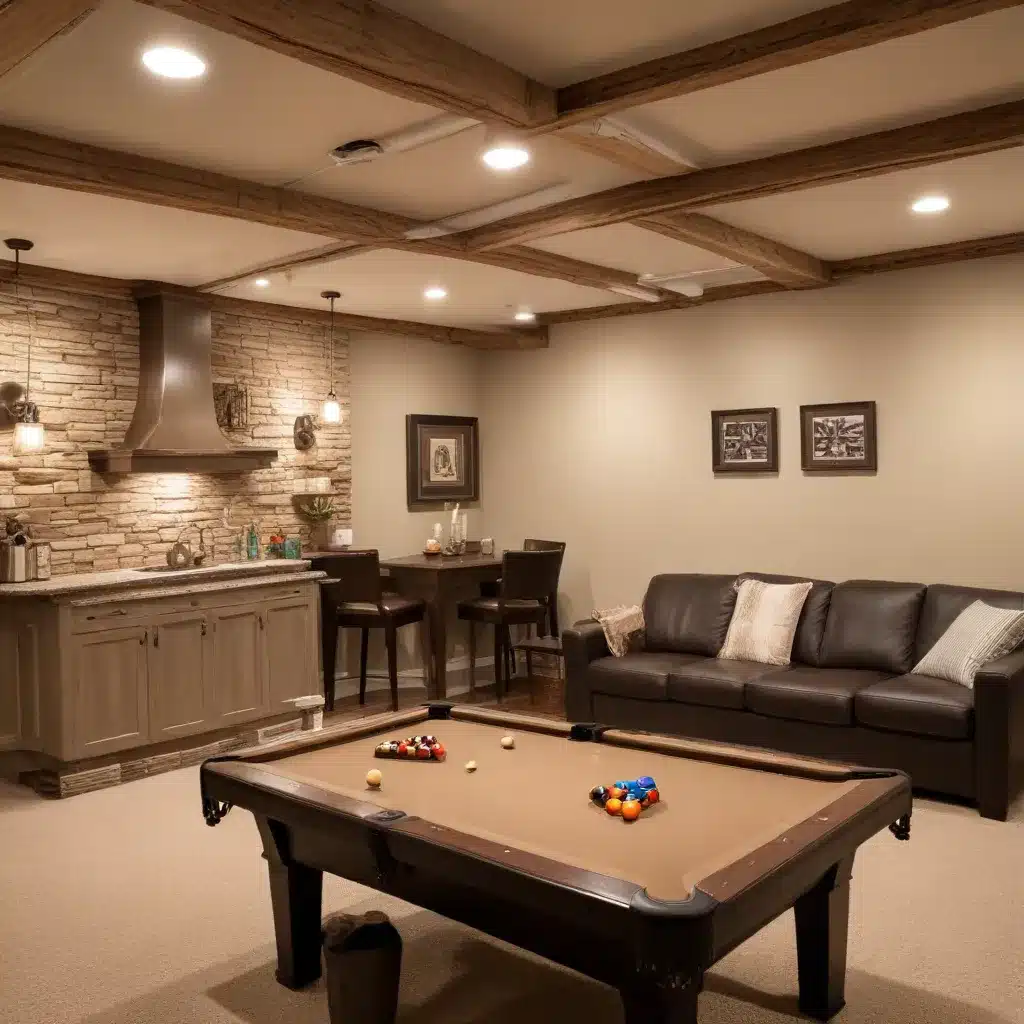Basement Remodel Inspiration: Transform Unused Space
Basements often become forgotten spaces – dark, damp areas used for storage or left completely neglected. But with a thoughtful remodel, your basement can be transformed into a stunning, functional extension of your home. Whether you dream of a cozy media room, a bright home office, or a versatile family lounge, unlocking the potential of your basement can add significant value and liveability to your property.
As an experienced home improvement consultant, I’m excited to share several budget-friendly, eco-friendly, and family-friendly basement remodeling ideas to inspire your next renovation project. From optimizing the layout and lighting to selecting the right materials and incorporating clever storage solutions, this comprehensive guide will equip you with the knowledge to turn your unused basement into a cherished living space.
Basement Design Considerations
Functionality and Layout
Before diving into the aesthetics, it’s crucial to carefully evaluate the functionality and layout of your basement. Assess the existing space – look for any structural issues, measure the ceiling height, and note the placement of windows and potential access points. This information will help you determine the best way to maximize the available square footage.
When planning the layout, think about how you intend to use the space. Will it be a dedicated home office, a cozy media lounge, or a versatile family rec room? Sketch out different zoning options, ensuring the flow between areas is intuitive and comfortable. Multipurpose furniture and built-in cabinetry can help you make the most of a compact basement, while open floor plans create a sense of spaciousness.
Lighting and Ventilation
Basements are notorious for feeling dark and damp, so investing in proper lighting and ventilation is crucial. Incorporate a mix of ambient, task, and accent lighting to create a balanced, inviting atmosphere. Recessed lighting, track lighting, and strategically placed lamps can all contribute to a well-lit basement. For ventilation, consider installing a dehumidifier or an energy-efficient HVAC system to maintain a comfortable temperature and minimize moisture buildup.
Insulation and Moisture Control
Proper insulation and moisture control are essential for a healthy, long-lasting basement remodel. Choose insulation materials with high R-values to improve energy efficiency and regulate the temperature. Pair this with a robust vapor barrier to prevent water infiltration and mold growth. Additionally, ensure that any existing or new windows, doors, and foundation are properly sealed to mitigate moisture issues.
Basement Finish Options
Drywall and Paneling
When it comes to wall finishes, drywall is a versatile and cost-effective option. For a more rustic or textured look, consider wood paneling, which can add warmth and character to your basement. If you’re aiming for a modern, sleek aesthetic, smooth drywall finished with a fresh coat of low-VOC paint can create a clean, polished appearance.
Flooring Choices
Basement floors need to be durable and moisture-resistant. Luxury vinyl plank (LVP) flooring is a popular choice, as it’s waterproof, easy to maintain, and available in a wide range of styles. Porcelain or ceramic tiles are another excellent option, offering excellent water resistance and a variety of design possibilities. For a more budget-friendly route, concrete floors with a decorative finish can also be a great choice.
Ceiling Treatments
Addressing the ceiling is an often overlooked, yet essential, aspect of basement remodeling. Exposed beams or joists can lend an industrial, loft-like ambiance, while drop ceilings or drywall can create a more polished, finished look. If you have the height, consider cathedral ceilings to amplify the sense of space and light.
Basement Storage Solutions
Built-in Cabinetry
Maximizing storage in a basement is key to maintaining a clutter-free, organized space. Built-in cabinets and shelving units can provide ample storage for everything from holiday decorations to craft supplies. Opt for moisture-resistant materials like laminate or sealed wood to ensure long-lasting durability.
Shelving and Organization
In addition to built-in storage, freestanding shelving units and modular storage solutions can be invaluable for organizing your basement. Use vertical space by installing floor-to-ceiling shelves, and incorporate labeled bins or baskets to keep items neatly arranged.
Multipurpose Furniture
When square footage is limited, multifunctional furniture can be a game-changer. Look for ottomans with hidden storage, murphy beds, or convertible sofas that serve double-duty as both seating and sleeping accommodations for guests.
Basement Entertainment Zones
Home Theater Setup
Transform a section of your basement into a home theater paradise. Incorporate a large flat-screen TV or projector screen, comfortable theater-style seating, and soundproofing for an immersive cinematic experience. Add smart home technology, like voice-controlled lighting and motorized blackout shades, for a truly high-tech setup.
Recreational Areas
Basements make an excellent setting for game rooms and entertainment hubs. Designate space for a pool table, foosball table, or vintage arcade games for endless hours of family fun. Supplement the activity area with a wet bar or kitchenette for convenient refreshments.
Wet Bar and Kitchenette
If you have the square footage, including a wet bar or mini-kitchen in your basement remodel can be a game-changer. Compact refrigerators, under-counter dishwashers, and streamlined cabinetry allow you to create a functional yet stylish food and beverage prep station, perfect for hosting guests or hosting family game nights.
Regardless of your specific basement renovation goals, the key is to approach the project with a strategic, well-planned vision. By carefully considering the functionality, finishes, and storage solutions, you can transform your underutilized basement into a cherished extension of your home that seamlessly integrates with your Reluctant Renovator lifestyle.




